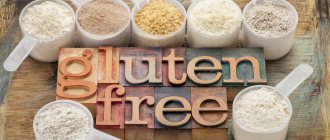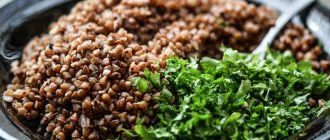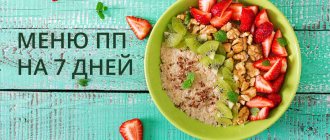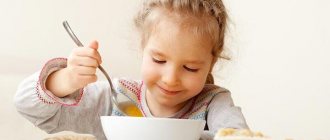General rules
Low-carbohydrate nutrition is represented by a wide range of low-carbohydrate diets, ranging from classic diets with a slight restriction of the carbohydrate component to the Keto diet , in which the traditional biochemical processes of providing the body with energy are excluded and an alternative mechanism for obtaining energy is launched.
One of the varieties of this type of diet is a high-fat, low-carbohydrate diet, the so-called low carb/high fat (LCHF diet), which translates as “low carbohydrates/high fat.” As you know, with normal nutrition, the main source of energy is carbohydrates ( glucose ), which generate energy through the process of metabolism ( glycolysis ). At the same time, nature also provides other metabolic mechanisms for energy production:
- gluconeogenesis - obtaining energy through the utilization of proteins;
- ketogenesis is the production of energy from adipose tissue, which during metabolism breaks down into ketone bodies.
With sufficient consumption of carbohydrates, the process of glycolysis occurs. At the same time, the level of insulin , which triggers the process of glycolysis. The resulting glucose is partially used for:
- energy supply to the body;
- deposited in the liver/muscles in the form of glycogen ;
- turns into fat and is deposited in the body (with excess glucose intake).
insulin is produced , which blocks a metabolic pathway for energy production such as ketogenesis ( lipolysis ). The diet of the vast majority of people in the modern world contains large amounts of starches and sugars. Essentially, the metabolism on this diet functions by producing increased levels of insulin and occurs outside of the process of ketosis , which is regarded as a potentially dangerous condition, accompanied by increased stress on the liver and contributing to the loss of muscle tissue.
However, this is not entirely true; the main danger is the process of “acidification” of the blood, which occurs in a number of diseases/conditions, in particular diabetes , fasting - the formation in large quantities of ketone bodies consisting of acetoacetic / hydroxybutyric acids / acetone , which are transported from the liver to peripheral tissues. But due to their high concentration in the incoming blood, the muscles/organs cannot cope with their oxidation, which leads to the development of ketonemia . Unlike “malignant”, benign dietary ketosis occurs against the background of normal insulin levels without symptoms of intoxication of the body.
Thus, the main goal of a high-fat diet is to achieve a state of dietary ketosis/lipolysis, in which the body begins to use its own stored fats to meet energy needs. In fact, the phenomenon of ketosis should be considered as a tool for transferring the body to the process of burning fats, which first break down into glycerol and free fatty acids, which continue, accordingly, to break down into so-called “ketone bodies” with the formation of a new fatty acid, which is used as fuel. Ketones are excreted from the body through the respiratory tract and urine.
The downside of a low-carb diet is the potentially high risk of muscle loss due to protein breakdown and cortisol- . This process is prevented by growth hormone, which counteracts cortisol, activating the process of penetration of amino acids into the muscles. You can also paralyze the effects of cortisol by eating more protein. In this case, the protein supplied with food will be used to obtain energy, and muscle protein will not be involved in the process.
According to scientific research, for this you need to get 2.5-3.0 protein/1 kg of body weight. But a more correct approach to the amount of protein consumed is the level of physical activity. That is, if you need to speed up fat burning and at the same time increase muscle mass, the protein content in the diet should be on average 3 g/kg of weight, and if there is no goal to build muscle, with standard physical activity, the protein component in the diet should be within the physiological range norms.
Thus, the diet should be high in fat, physiologically sufficient in protein and very low in carbohydrates (20-50 g/day). It is also important to constantly monitor the total carbohydrate content, especially the so-called “hidden” carbohydrates, and maintain a high level of fat in the diet so as not to leave the ketosis process. To do this, the level of carbohydrate content should not exceed an average of 50 g/day. Many people do not understand the difference between ketogenic diets and a standard low-carbohydrate diet with carbohydrate restriction in the diet at the level of 150-200 g/day, in which the process of ketosis does not start.
That is, the compositions of the main dietary macronutrients in traditional low-carbohydrate diets do not meet the requirements of ketogenic diets. Ideally, when trying to lose weight, it is advisable not to leave ketogenesis before reaching the target level, since this state is quite comfortable for losing weight and, moreover, there is no need to re-activate this mechanism. It should be remembered that stopping ketogenesis is quite simple, even without knowing it. Therefore, remember that even a small intake of an unexpected additional amount of carbohydrates (a bun, a bagel) will take your body out of ketosis and the process will have to be restarted. Signs of the body’s transition to ketogenesis are:
- decreased appetite;
- the appearance of ketones in the urine (test with special strips);
- the appearance of the smell of acetone from the mouth, sweat, urine;
- improved mood, increased energy, increased strength/vigor.
Classic low-carbohydrate diets (low-fat/low-calorie), unlike keto diets, are accompanied throughout their entire duration by lethargy, weakness, a feeling of constant hunger, and decreased performance. At the same time, average fat burning, low insulin , and loss of muscle mass are observed.
Many may wonder if there are differences between the keto diet and the LCHF diet, and if so, what are they? There is no fundamental difference. Each of them is based on the process of ketosis, but the LCHF diet is a milder nutritional option. Now let's look at the LCHF diet in more detail.
The approximate standard for the content of basic food nutrients in the diet is 20% proteins, 70-75% fats and 5-10% carbohydrates. With a strict version of the LCHF diet, carbohydrate intake is limited to 10-20 g/day, with a more liberal version - 50 g. At the same time, the ratio of proteins and fats in the first days of the diet should be 1:1, and only after the body passes through the “metabolic threshold” the level of fat in the diet increases to 70-75%.
The question of the total calorie content of the daily diet is also of some interest, since most people assume that if there are no strict restrictions on protein and fatty foods, then they can be consumed in any quantity. This is not entirely correct, since the overall energy value of the diet is of primary importance, but it all depends on the task at hand.
If your goal is simply to lose weight, then it is recommended to reduce the caloric content of your daily diet by 500-600 kcal from the norm. If your goal is to gain muscle mass while burning fat, then the calorie content of your diet increases by 500-600 Kcal. These indicators can vary significantly depending on the level of metabolism/energy consumption of the body.
The positive aspects of the LCHF diet when trying to lose weight are:
- Body weight is lost due to adipose tissue.
- Weight loss is accompanied by a general improvement of the body, due to the stimulation of CMA autophagy - a cellular process of removing organelles, proteins and foreign bodies from the aqueous component of the cell ( cytosol ) and transporting them to lysosomes for disposal. In addition, against the background of low-carbohydrate ketogenic diets, metabolic effects such as a decrease in blood glucose levels, excretion of ketone bodies in the urine, normalization of insulin levels/lipid profile, and normalization of blood pressure .
- Weight loss occurs without the feeling of hunger and in a state of psychological comfort.
When building an LCHF diet, carbohydrates are primarily limited. Sugars and their artificial substitutes, sweets, sweet juices, cakes, chocolate, buns, cakes, pastries, honey, jam, ice cream, jam, honey, sauces with added sugar, sweet juices, curds, jelly/compotes, sweet yoghurts are excluded.
The list of prohibited products includes products containing starch (pasta, bread - black/white, cereals, chips, rice, muesli and all whole grain products - bread, sunflower seeds), legumes.
Sweet fruits, dried fruits and all root vegetables (beets, carrots, celery root, potatoes) containing a lot of starch and sugars, alcoholic beverages, especially beer, kvass, sweet/semi-sweet wines are excluded.
Above-ground vegetables (eggplant, cucumbers, tomatoes, onions, all types of cabbage, zucchini/zucchini, leafy greens) may be present in the diet as a carbohydrate component. Unsweetened fruits/berries and nuts (cashews, walnuts, flaxseed, sesame) are allowed in minimal quantities.
It is recommended to exclude trans fats from the fat part of the diet (spreads with trans fats, margarine); if lactose is intolerant, use whole/skimmed milk. Protein products and fatty foods are allowed - concentrated fatty broths, fatty meats/sea and river fish (cod, salmon, salmon, herring), meat products (bacon, boiled pork, balyk, sausages), fatty poultry meat (goose, duck), butter/vegetable oil, high-fat dairy/fermented milk products, sauces/homemade mayonnaise, fatty hard/soft cheeses, eggs, mushrooms, seafood (shrimp, squid), bran.
It is recommended to use animal proteins as the protein component. It is extremely important to control the amount of free fluid consumed, the volume of which should be at least 3.0 l/day at the rate of 40 ml/1 kg of weight. The salt content and the limitation of various types of pickles are also slightly limited. Diet: at least 5 times a day with an interval between meals of no more than 3-4 hours. The last meal is 3-3.5 hours before bedtime.
Characteristics of a gluten-free diet
A gluten-free diet is prescribed for celiac enteropathy caused by intolerance to the gluten protein.
The diet is complete, with the complete exclusion of wheat, rye, barley, oats, with a high content of protein, calcium salts and a slightly increased energy value. The diet is mechanically and chemically gentle; dishes that increase fermentation processes are excluded.
Two diet options are recommended: the first for overweight patients; the second is for people with normal or low body weight.
Culinary processing: all dishes are served boiled or steamed. Depending on the functional state of the intestines, food is crushed or pureed (during diarrhea) or prepared without special grinding (during normalization of stool). During the period of stable remission, cooking methods such as baking and light frying are recommended.
Diet: 5-6 times a day.
Food temperature: hot dishes - 57–62 °C, cold dishes - not lower than 15 °C. Hot and cold foods are excluded.
Chemical composition and energy value: proteins - 100-120 g, fats - 100-110 g, carbohydrates - 400-450 g, calorie content - 2940-3270 kcal, table salt - 6-7 g, free liquid - 1.5 liters.
The first version of the gluten-free diet
Proteins - 95-110 g, fats - 90-100 g, carbohydrates - 250-350 g, calorie content 2235-2540 kcal, table salt - 3-4 g, free liquid - 1.5-2 liters.
The norms of therapeutic nutrition are applied (approved by Order of the Ministry of Health of Russia dated June 21, 2013 No. 395n “On approval of norms of therapeutic nutrition”) when following a diet with a physiological amount of protein while reducing the calorie content of the diet (a variant of a diet with reduced calorie content) with the inclusion of specialized food products, mixtures of dry protein composites (SBCS) in a volume of 24 g of the mixture (for example, when using SBCS "Diso®" "Nutrinor" - 9.6 g of protein) as part of a daily set of products. Protein correction of the standard diet is carried out in accordance with Order of the Ministry of Health of Russia dated June 21, 2013 No. 395n “On approval of therapeutic nutrition standards.”
Want more new information on nutrition issues? Subscribe to the informational and practical magazine “Practical Dietetics”!
SUBSCRIBE
Second version of the gluten-free diet
Proteins - 100–120 g; fats - 100–110 g; carbohydrates - 300–400 g; calorie content 2500-2900 kcal, table salt - 6-7 g, free liquid - 1.5-2 liters.
The norms of therapeutic nutrition are applied when following a diet with a physiological amount of protein (the main version of the standard diet) with the inclusion of specialized food products, mixtures of dry protein composites in a volume of 27 g of the mixture (for example, when using SBCS "Diso®" "Nutrinor" - 10.8 g of protein ) as part of a daily set of products. Protein correction of the standard diet is carried out in accordance with Order of the Ministry of Health of Russia dated June 21, 2013 No. 395n “On approval of therapeutic nutrition standards.”
Authorized Products
The diet of the LCHF diet is formed mainly due to:
- fatty meat/fish broths and first courses based on them (solyanka, borscht);
- red meat of fatty varieties in any culinary processing, meat products (ham, bacon, sausages, smoked meats), poultry meat (chicken, duck, goose);
- fatty varieties of river/sea fish (salmon, tuna, herring), seafood;
- chicken eggs, fatty sauces;
- high-fat dairy products (butter, cream, sour cream, cottage cheese, hard cheese);
- vegetable oils (olive, corn, sunflower, flaxseed);
- above-ground vegetables (celery stalks, eggplants, cucumbers, tomatoes, onions, all types of cabbage, zucchini/zucchini, green beans, leafy greens).
- nuts/seeds (walnuts, cashews, peanuts, flax seeds, olives, sesame).
Table of permitted products
| Proteins, g | Fats, g | Carbohydrates, g | Calories, kcal | |
Vegetables and greens | ||||
| green peas | 5,0 | 0,2 | 13,8 | 73 |
| zucchini | 0,6 | 0,3 | 4,6 | 24 |
| Brussels sprouts | 4,8 | 0,0 | 8,0 | 43 |
| cabbage | 1,2 | 0,2 | 2,0 | 16 |
| cauliflower | 2,5 | 0,3 | 5,4 | 30 |
| cucumbers | 0,8 | 0,1 | 2,8 | 15 |
| olives | 0,8 | 10,7 | 6,3 | 115 |
| iceberg lettuce | 0,9 | 0,1 | 1,8 | 14 |
| celery | 0,9 | 0,1 | 2,1 | 12 |
| green beans | 2,8 | 0,4 | 8,4 | 47 |
Mushrooms | ||||
| mushrooms | 3,5 | 2,0 | 2,5 | 30 |
Nuts and dried fruits | ||||
| nuts | 15,0 | 40,0 | 20,0 | 500 |
| peanut | 26,3 | 45,2 | 9,9 | 551 |
| flax seeds | 18,3 | 42,2 | 28,9 | 534 |
Cereals and porridges | ||||
| white rice | 6,7 | 0,7 | 78,9 | 344 |
Raw materials and seasonings | ||||
| mayonnaise | 2,4 | 67,0 | 3,9 | 627 |
Dairy | ||||
| milk 3.2% | 2,9 | 3,2 | 4,7 | 59 |
| condensed milk | 7,2 | 8,5 | 56,0 | 320 |
| kefir 3.2% | 2,8 | 3,2 | 4,1 | 56 |
| cream 20% (medium fat content) | 2,8 | 20,0 | 3,7 | 205 |
| sour cream 25% (classic) | 2,6 | 25,0 | 2,5 | 248 |
| Ryazhenka 6% | 5,0 | 6,0 | 4,1 | 84 |
Cheeses and cottage cheese | ||||
| cheese | 24,1 | 29,5 | 0,3 | 363 |
Meat products | ||||
| pork | 16,0 | 21,6 | 0,0 | 259 |
| salo | 2,4 | 89,0 | 0,0 | 797 |
| boiled beef | 25,8 | 16,8 | 0,0 | 254 |
| boiled veal | 30,7 | 0,9 | 0,0 | 131 |
| rabbit | 21,0 | 8,0 | 0,0 | 156 |
| bacon | 23,0 | 45,0 | 0,0 | 500 |
| ham | 22,6 | 20,9 | 0,0 | 279 |
| raw smoked pork loin | 10,5 | 47,2 | — | 467 |
| meat pate | 16,4 | 23,3 | 0,4 | 277 |
| pork cutlets | 13,6 | 45,7 | 8,8 | 466 |
Sausages | ||||
| smoked sausage | 28,2 | 27,5 | 0,0 | 360 |
| dry-cured sausage | 24,1 | 38,3 | 1,0 | 455 |
| smoked sausage | 9,9 | 63,2 | 0,3 | 608 |
| sausages | 10,1 | 31,6 | 1,9 | 332 |
| sausages | 12,3 | 25,3 | 0,0 | 277 |
Bird | ||||
| boiled chicken | 25,2 | 7,4 | 0,0 | 170 |
| turkey | 19,2 | 0,7 | 0,0 | 84 |
| duck | 16,5 | 61,2 | 0,0 | 346 |
| goose | 16,1 | 33,3 | 0,0 | 364 |
Eggs | ||||
| soft-boiled chicken eggs | 12,8 | 11,6 | 0,8 | 159 |
Fish and seafood | ||||
| pink salmon | 20,5 | 6,5 | 0,0 | 142 |
| Red caviar | 32,0 | 15,0 | 0,0 | 263 |
| cod roe | 24,0 | 0,2 | 0,0 | 115 |
| salmon | 19,8 | 6,3 | 0,0 | 142 |
| seafood | 15,5 | 1,0 | 0,1 | 85 |
| sturgeon | 16,4 | 10,9 | 0,0 | 163 |
| canned fish | 17,5 | 2,0 | 0,0 | 88 |
| herring | 16,3 | 10,7 | — | 161 |
| cod (liver in oil) | 4,2 | 65,7 | 1,2 | 613 |
| tuna | 23,0 | 1,0 | — | 101 |
| acne | 14,5 | 30,5 | — | 332 |
| sprats | 17,4 | 32,4 | 0,4 | 363 |
Oils and fats | ||||
| vegetable oil | 0,0 | 99,0 | 0,0 | 899 |
| butter | 0,5 | 82,5 | 0,8 | 748 |
| linseed oil | 0,0 | 99,8 | 0,0 | 898 |
| animal fat | 0,0 | 99,7 | 0,0 | 897 |
| cooking fat | 0,0 | 99,7 | 0,0 | 897 |
Non-alcoholic drinks | ||||
| mineral water | 0,0 | 0,0 | 0,0 | — |
| green tea | 0,0 | 0,0 | 0,0 | — |
| black tea | 20,0 | 5,1 | 6,9 | 152 |
| * data is per 100 g of product | ||||
LCHF meals at home
Most often I have eggs . This is such a tasty and versatile product that you don’t get tired of them at all. I even collected my favorite recipes in a book (you can use it). I love crispy bacon ; I often fry scrambled eggs and omelettes in melted bacon fat.
In second place on my breakfast list are cheesecakes, pancakes made from curd cheese and vegetables, and casseroles. Definitely with rich sour cream.
For lunch and dinner we have something fatty and protein (French meat, salmon in cream, chicken in sour cream and pesto, beef stroganoff in cream) and fresh vegetables. I often buy avocados. In our latitudes it is not always possible to find ripe ones at an adequate price, but nothing is impossible. In the end, you can always buy a “wooden” fruit and let it finish.
We often have both fresh salad and sauerkraut seasoned with olive oil to accompany the meat.
I cook with ghee and coconut oil . In the United States, pork, beef and goose fat are now available in supermarkets everywhere; lately I have been making poultry meat dishes using pork fat. It is delicious, although the smell during the cooking process is specific. Avocado and olive oil are used in salads and sauces. Creamy - in baked goods and fat bombs. I can’t say that I eat a lot of butter at home, but in a restaurant I always do. I recently discovered salted whipped butter - I’ve been destroying it on an industrial scale lately, it’s surprising that it didn’t make it into the 5 days that I wrote it down.
I love lard, I have periods when I eat it non-stop, then let it go. In a Ukrainian restaurant I always take lard. I don’t see anything wrong with sausage if it is fatty (Italian salami, for example) and does not have added sugar, starch, dextrose, maltodextrim, etc. My principle is that if you don’t have to google the ingredients in a product, you can eat it.
Want to learn how to live long and think fast?
Take the test
Fully or partially limited products
The LCHF diet includes dietary restrictions:
- sugar, jam, jams, honey, sweets, chocolate, ice cream, sorbitol/fructose products;
- white bread, cereals, pasta, crackers, pastries, cookies, cakes, waffles;
- starchy vegetables (potatoes, beets, carrots, eggplants, celery root);
- sweet fermented milk products, various dried fruits, sweet carbonated drinks, milk, powdered drinks, bran;
- sweet fruits and juices from them (grapes, banana, melon, watermelon), beer, kvass, sweet/semi-sweet/fortified wines, caffeine-containing drinks (cola, Pepsi), jelly, compotes.
Table of prohibited products
| Proteins, g | Fats, g | Carbohydrates, g | Calories, kcal | |
Vegetables and greens | ||||
| potato | 2,0 | 0,4 | 18,1 | 80 |
| carrot | 1,3 | 0,1 | 6,9 | 32 |
| radish | 1,2 | 0,1 | 3,4 | 19 |
| turnip | 1,5 | 0,1 | 6,2 | 30 |
| beet | 1,5 | 0,1 | 8,8 | 40 |
Berries | ||||
| grape | 0,6 | 0,2 | 16,8 | 65 |
Snacks | ||||
| potato chips | 5,5 | 30,0 | 53,0 | 520 |
Cereals and porridges | ||||
| buckwheat porridge with milk | 4,2 | 2,3 | 21,6 | 118 |
| semolina | 10,3 | 1,0 | 73,3 | 328 |
| pearl barley | 9,3 | 1,1 | 73,7 | 320 |
| Wheat groats | 11,5 | 1,3 | 62,0 | 316 |
| millet cereal | 11,5 | 3,3 | 69,3 | 348 |
| white rice | 6,7 | 0,7 | 78,9 | 344 |
Flour and pasta | ||||
| pasta | 10,4 | 1,1 | 69,7 | 337 |
| spaghetti | 10,4 | 1,1 | 71,5 | 344 |
| pancakes | 6,1 | 12,3 | 26,0 | 233 |
| vareniki | 7,6 | 2,3 | 18,7 | 155 |
| dumplings | 11,9 | 12,4 | 29,0 | 275 |
Bakery products | ||||
| vysivkovy bread | 9,0 | 2,2 | 36,0 | 217 |
| Rye bread | 6,6 | 1,2 | 34,2 | 165 |
Confectionery | ||||
| jam | 0,3 | 0,2 | 63,0 | 263 |
| jam | 0,3 | 0,1 | 56,0 | 238 |
| candies | 4,3 | 19,8 | 67,5 | 453 |
| cookie | 7,5 | 11,8 | 74,9 | 417 |
| crackers with raisins | 8,4 | 4,9 | 78,5 | 395 |
| dough | 7,9 | 1,4 | 50,6 | 234 |
Ice cream | ||||
| ice cream | 3,7 | 6,9 | 22,1 | 189 |
Cakes | ||||
| cake | 4,4 | 23,4 | 45,2 | 407 |
Chocolate | ||||
| chocolate | 5,4 | 35,3 | 56,5 | 544 |
Raw materials and seasonings | ||||
| honey | 0,8 | 0,0 | 81,5 | 329 |
Dairy | ||||
| fruit yogurt 3.2% | 5,0 | 3,2 | 8,5 | 85 |
Alcoholic drinks | ||||
| liquor | 0,3 | 1,1 | 17,2 | 242 |
| beer | 0,3 | 0,0 | 4,6 | 42 |
| cider | 0,2 | 0,3 | 28,9 | 117 |
Non-alcoholic drinks | ||||
| cola | 0,0 | 0,0 | 10,4 | 42 |
| coffee with milk and sugar | 0,7 | 1,0 | 11,2 | 58 |
| Pepsi | 0,0 | 0,0 | 8,7 | 38 |
| energy drink | 0,0 | 0,0 | 11,3 | 45 |
Juices and compotes | ||||
| compote | 0,5 | 0,0 | 19,5 | 81 |
| grape juice | 0,3 | 0,0 | 14,0 | 54 |
| pear juice | 0,4 | 0,3 | 11,0 | 46 |
| jelly | 0,2 | 0,0 | 16,7 | 68 |
| raspberry juice | 0,8 | 0,0 | 24,7 | 100 |
| * data is per 100 g of product | ||||
Menu (Power Mode)
The menu for a week of the LCHF diet is based on a list of allowed/prohibited foods. The main task when creating a menu is to control the total content of the carbohydrate component in the diet and maintain a high level of fat in the diet so as not to interrupt the ketogenesis process.
Therefore, when drawing up a menu for the day/week, it is necessary to carefully examine the composition of products for “hidden” carbohydrates. The rate of protein consumption and the total calorie content of the diet depends on the goal - losing weight, burning fat while maintaining weight, gaining muscle mass.
Advantages and disadvantages
| pros | Minuses |
|
|
Comments from nutritionists
Against the background of the LCHF diet, functional disorders of the gastrointestinal tract (bloating and heaviness in the stomach, constipation / diarrhea ), general weakness, fatigue, nausea, insomnia , headache , dizziness , thirst are possible. Such phenomena most often occur during the transition of the body from glycolysis to ketogenesis , so it is recommended to reduce this period if possible by increasing physical activity and minimally including a carbohydrate component in the diet to 6-10 g/day and a gradual increase to 30-40 g/day day. At this time, it is important to activate the kidneys and ensure rapid evacuation of intestinal contents.
Limiting carbohydrates and, accordingly, fiber contributes to the development/colonization of the intestines by pathogenic microflora with a high risk of developing dysbiosis /decreased immunity . It is recommended to periodically include some vegetables/fruits (cabbage, sour apples) in the diet in minimal quantities.
For those on a diet with minimal carbohydrates, it is recommended to take fiber supplements containing both soluble and insoluble fiber. These drugs do not contain carbohydrates. However, it should be remembered that it is better to use fiber in powder form, dissolving in water. When consumed in dry form, additional intake of large amounts of water is necessary.
Since the LCHF diet does not provide the body with all the necessary micronutrients, it is recommended to take supplements containing a full spectrum of water/fat-soluble vitamins and minerals.
My menu at LCHF
I don’t keep a food diary, I don’t write down food intake and calories - I focus on my well-being and feeling of hunger. But I decided to do the math specifically for this text. I spent 100 hours on this and, to be honest, I broke down after five days. How do people who watch their caloric intake live? In the end, I decided not to indicate the total calorie content of my diet at all, this information will confuse you more than it will help you.
On average, my diet contains from 20 to 40 g of carbohydrates. In my case, this is enough to provide the intestinal microbiota with a variety of foods and keep my weight stable. Everyone has different sensitivities to carbohydrates. Some eat up to 100 and don’t give a damn, while others start to gain weight at 50 and don’t lose weight until they reduce it to 10 g per day.
This menu and the amounts of food can only be a guide for you, but I strongly advise you not to copy it, but to eat when you are hungry until you feel full. Everyone has a different metabolism , carbohydrate sensitivity, and activity level.
My input data: 45-47 kg (I'll weigh myself when the opportunity arises, honestly!), height 160 cm, 2-3 fitness classes per week, lots of walks in hilly areas. You can see what the big man and founder of lchf.ru Sam Klebanov eats on his website.
Reviews and results
Reviews of the LCHF diet among its practitioners vary significantly from enthusiastic to complete denial.
- “... In my many attempts to lose my extra 15 kg of weight, I found the LCHF diet, which I decided to practice. Despite the clear logic of all the processes on this diet, I was still afraid of it, but decided to stay on it for only 2 weeks. Strictly controlled carbohydrates. For the first 4 days I felt terrible (weakness, irritability). But from day 5 the condition improved noticeably. There was a smell of acetone when exhaling, I drank a lot of liquid. Lost 6.5 kg in 2 weeks”;
- “... I found a description of this diet in the literature and wanted to practice it, but did not dare, because on the Internet there were numerous negative reviews about the LCHF diet, and not just from people practicing it, but from doctors, according to whom, to go on any ketone diet without There are no specific medical indications, since a pronounced imbalance of fats/proteins/carbohydrates slows down metabolic processes and subsequently provokes weight gain, in even greater quantities. In addition, a diet based on fat and protein often provokes salt deposition and gout, increased cholesterol levels, which increases the risk of developing cardiovascular diseases, and decreased testosterone levels.”
How is keto different from LCHF?
The keto diet is necessarily a LCHF diet, low in carbohydrates and high in fat. But not every LCHF diet is keto.
A prerequisite for the keto diet is ketosis, a metabolic state when the main fuel is fat. There is no ketosis on moderate and especially liberal LCHF, but this does not mean that they are worse than keto. Many people are comfortable on a low-carbohydrate diet; LCHF foods provide a lot of nutrients, but pro-inflammatory foods are excluded - the list of permitted foods is the same.
Is LCHF only suitable for rich people who can afford expensive foods like avocados?
No. Even a student living on a scholarship can follow LCHF.
Can you arrange a cheat day for yourself? Or at least one cheat meal every 7-10 days?
Who will stop you? But why? Cheat meals (foods that do not correspond to the diet, for example, Snickers) are needed by PP girls so as not to go completely crazy on bland, tasteless food.
Fat makes food bright, rich, and interesting. We use a huge amount of natural ingredients. Therefore, every day the lowcarber enjoys food. The craving for sweets goes away on its own. For those who are nostalgic, there are always healthy versions of classic recipes: if you want tiramisu, if you want chocolate mousse.
What to do with failures on keto?
Do I still have questions? May I ask?
Of course, leave it in the comments or write to [email protected]










